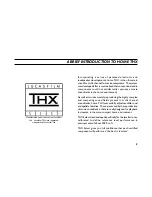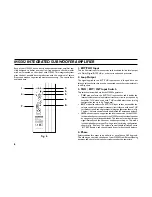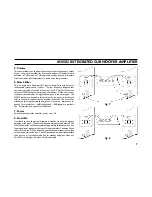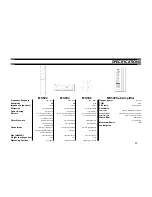
8
SUBWOOFER TUNING FOR OPTIMUM SOUND QUALITY
Your MS500 system incorporates subwoofers built into the left and right
front speakers to generate substantial amounts of low-frequency energy
for a satisfying bass response. In addition the M500 system has been
designed to give a substantially flat frequency response.
However, the dimensions of some rooms and the positioning and nature
of furniture can cause the bass response to be uneven. Typically rooms
with this problem exhibit a ‘room mode’ where the room dimensions cause
reinforcement of a narrow band of frequencies. This leads to a slightly
‘boomy’ sound where a small band of frequencies appear louder than
normal.
If you experience this problem, we advise that you first experiment with
speaker placement. Begin by adjusting the distance between the speakers
and the distance from the speakers to the back wall etc. until a satisfactory
response is obtained. Remember to always use your ears as the ultimate
guide. Remember what sounds right to you, IS the optimum solution
regardless of measurements etc. that you may take.
If speaker placement alone is insufficient to solve these problems we have
incorporated a sophisticated notch filter that allows you to attenuate a small
range of frequencies for a more even, flatter bass. See instructions below:
Equipment required
• EQ Test CD (supplied) containing eight test tones that will highlight any
low frequency ‘room mode’ resonances.
• Sound Pressure Level (SPL) meter (not supplied): This gives an
accurate measure of the volume level of the tones emitted from the test
CD. SPL meters are available from Radio Shack (US), Maplin (UK) and
all good electrical shops. If you are unable to locate one ask your
dealer for advice.
Instructions
1. Start by placing your loudspeakers in their intended locations (positioning
is discussed on page 5), ensuring that the notch filter is set to the OFF
position on both units.
2. Set the levels of the whole speaker system as required for optimum
response (fixed in THX mode).
3. Sitting in the listening position (as per fig.5) set the SPL meter range to
75 dB, it’s weighting to C, and set the response to slow if it has a slow/
fast response setting.
4. The supplied test CD includes eight tracks, each one a specially
recorded tone at 1/6 octave spacing (in addition, each tone corresponds
to a value on the supplied table).
5. Play each track on the CD in turn. Sitting in the listening position and
using the table provided, record the reading shown on your SPL meter
for each track played on the table provided. Should any one frequency
be 6dB-12dB above the average of the others, then use of the Notch
filter may be beneficial. Proceed as follows.
6. Go to the rear of each MS502 and switch the notch filter to its –6dB
setting and adjust the notch filter frequency knob to the approximate
frequency of the highest reading taken as above.
Always adjust both
notch filters (one for each speaker) together in tandem.
7. Play the test CD again and record a second set of SPL readings in the
table to verify the improved flatness of response.
8. Repeat steps 5 and 6 until a satisfactory fairly flat response is obtained.





























